08 Semana Santa en Tilcara, 31 de Marzo 2010
Tilcara. La Semana Santa reviste no sólo la sacralidad de estos días en el mundo cristiano sino que denota la especial devoción con que los lugarenos evocan la Vida y la Pasión de Cristo. El Lunes Santo, en horas de la noche se inicia la peregrinación al santuario de la Virgen del Abra de Punta Corral, distante a unas 35km en plena montana. Una multitud de promesantes y devotos de todos los edades y condiciones sube para buscar la "Mamita", como llaman comúnamente a la Virgen Maria.
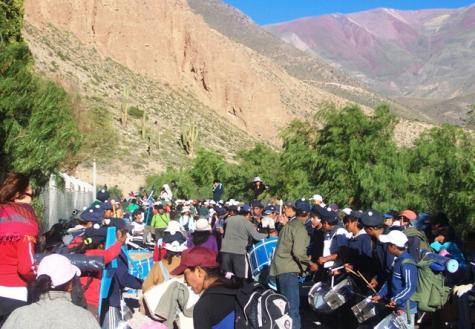
The individual or group players and the music of the many "sikuri" bands accompany the dificult ascent (up to 3860m) and makes them forget the intensive cold of the night. In Abra there are mases and prayers, and on the morning of Easter Wednesday the procession starts to descent to Tilcara, carying the Virgin in a glass urn garlanded with flowers and covered with a white "lienzo", so she will not get dirty during the journey. At the entry of the town, a crowd awaits the arrival of the image.
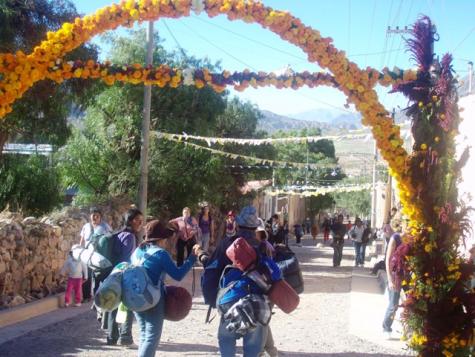
Ale und ich sind am Mittwochnachmittag nach Tilcara gefahren um die Prozession der Heiligen Copacabana aus Abra de Punta Corral zu sehen. Die Pilger steigen aus 3860m Höhe nach Tilcara herunter, und legen dabei eine Strecke von 35km zurück. Als wir um 16:30 in Tilcara ankamen, waren die Bewohner noch beim Dekorieren.
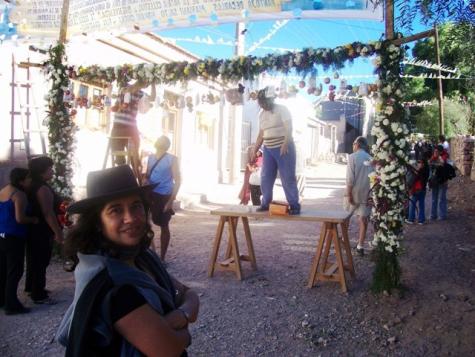
El primer grupo de música que vimos fue una banda "Sikuri" de San Jose.
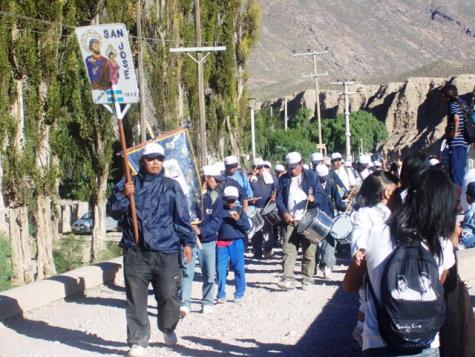
Another "sikuri" band called "Maria Rosa Mística", a band of women.
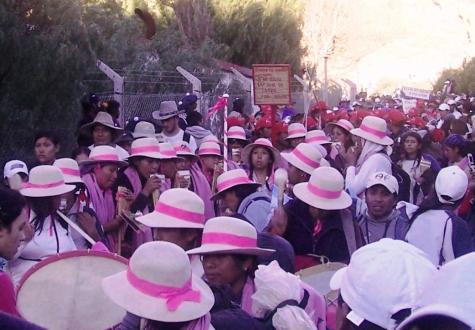
Die Prozession ging bis in die Nacht, denn der durch Regen aufgeweichete Weg verspätete die Träger der Heiligen von Copacabana.
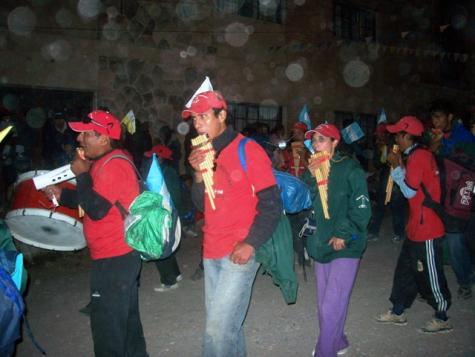
Hay que imaginar el trayecto que hicieron estos chicos: 35km y con los instumentos.
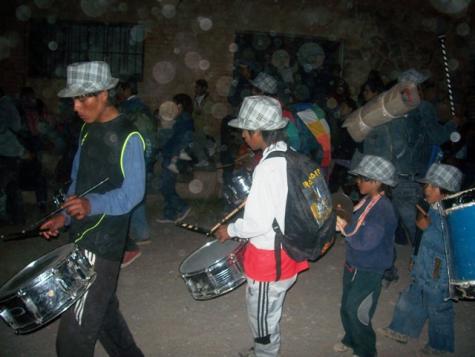
Holy Week in Tilcara: There is also the custom of setting up huge pictures made of seasonal fruit and flower. Tilcara divides into occupational sectors, neighbourhoods, public and private institutions to make these screens and create with corn, "aromos", "totoras", poplars, "estatis", carnations, chrysanthemums, etc. scenes of Jesus' public life with their respective popular recreations.
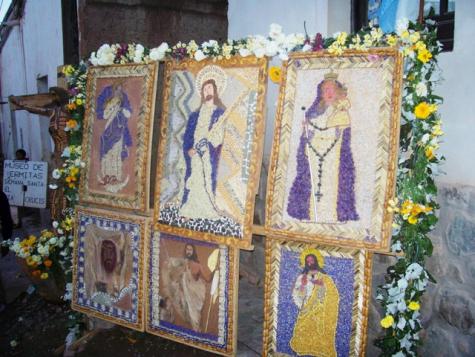
Es werden auch die 14 Stationen des Leidensweges Christi nachgestellt und dafür stellen die Bewohner Tilcara's Bilder und Statuen aus Blumen, Körner, Saaten her. Der Christus ist an einem Kreuz aus Kaktusholz (Cardón), selbst hergestellt aus verschiedenfarbigen Maiskörnern. Hier spiegelt sich die Verbindung zwischen Ostern und Erntedankfest wieder, da hier gerade der Spätsommer zu Ende geht.
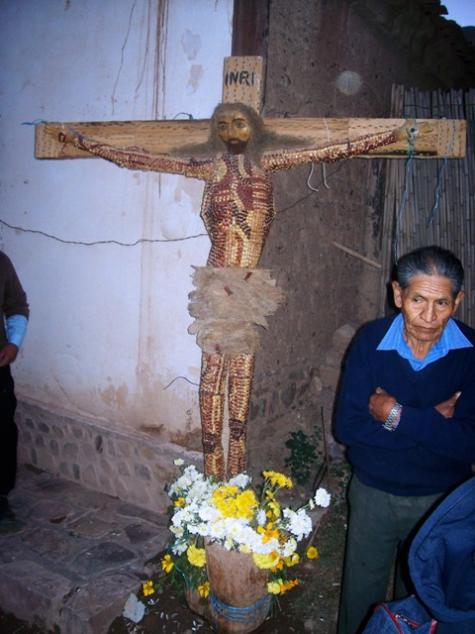

The individual or group players and the music of the many "sikuri" bands accompany the dificult ascent (up to 3860m) and makes them forget the intensive cold of the night. In Abra there are mases and prayers, and on the morning of Easter Wednesday the procession starts to descent to Tilcara, carying the Virgin in a glass urn garlanded with flowers and covered with a white "lienzo", so she will not get dirty during the journey. At the entry of the town, a crowd awaits the arrival of the image.

Ale und ich sind am Mittwochnachmittag nach Tilcara gefahren um die Prozession der Heiligen Copacabana aus Abra de Punta Corral zu sehen. Die Pilger steigen aus 3860m Höhe nach Tilcara herunter, und legen dabei eine Strecke von 35km zurück. Als wir um 16:30 in Tilcara ankamen, waren die Bewohner noch beim Dekorieren.

El primer grupo de música que vimos fue una banda "Sikuri" de San Jose.

Another "sikuri" band called "Maria Rosa Mística", a band of women.

Die Prozession ging bis in die Nacht, denn der durch Regen aufgeweichete Weg verspätete die Träger der Heiligen von Copacabana.

Hay que imaginar el trayecto que hicieron estos chicos: 35km y con los instumentos.

Holy Week in Tilcara: There is also the custom of setting up huge pictures made of seasonal fruit and flower. Tilcara divides into occupational sectors, neighbourhoods, public and private institutions to make these screens and create with corn, "aromos", "totoras", poplars, "estatis", carnations, chrysanthemums, etc. scenes of Jesus' public life with their respective popular recreations.

Es werden auch die 14 Stationen des Leidensweges Christi nachgestellt und dafür stellen die Bewohner Tilcara's Bilder und Statuen aus Blumen, Körner, Saaten her. Der Christus ist an einem Kreuz aus Kaktusholz (Cardón), selbst hergestellt aus verschiedenfarbigen Maiskörnern. Hier spiegelt sich die Verbindung zwischen Ostern und Erntedankfest wieder, da hier gerade der Spätsommer zu Ende geht.

Our weather in Jujuy
Navigation
News / Novedades
- Welcome to VISIT JUJUY - Bienvenido! (addisnews, 05.ago.12)
- UN Special Rapporteur on the Rights of Indigenous... (addisnews, 05.ago.12)
- Alejandra's Projekt in Jujuy (addisnews, 19.abr.12)
Our Links
Search / Buscador
Membership
Archivo
- abril 2010lunmarmiéjueviesábdom123456789101112131415161718192021222324252627282930
RSS